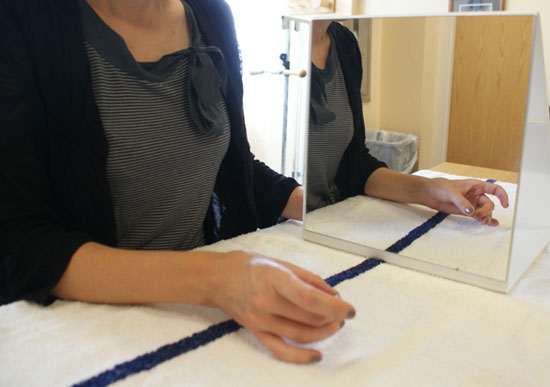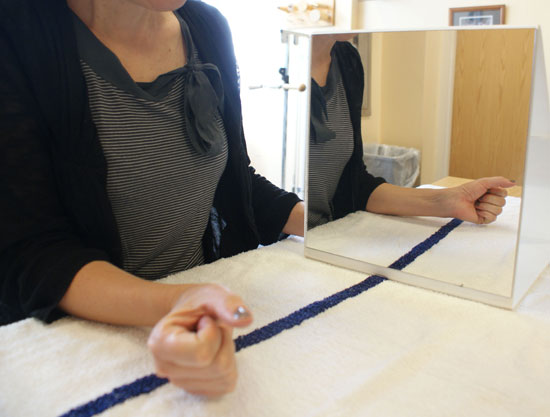Using Mirror Therapy to Reduce Pain and Improve Movement
Reestablishing the Connection
Managing chronic or persistent pain in patients with hand injuries or disease, constitutes a complex and challenging issue for hand therapists. When patients fail to respond to therapeutic tools including thermal modalities, splinting, various manual interventions, functional activities, or even anti-inflammatory medications, "thinking outside the box", and beyond just the painful hand or wrist, can help.
Graded Motor Imagery (GMI) is one technique to consider when challenged with a complex patient’s pain. Priganc & Stralka have described GMI as a "top down" treatment program designed to help reorganize brain processes via stimulation of the patient’s motor and sensory systems. (1) This training program involves three sequential phases:
- laterality training
- motor imagery
- mirror visual feedback
Laterality training includes the identification of right versus left via picture cards. Until patients suffering from disabling pain can establish an "accurate cortical representation of their body," the program should not continue on to the next phase.(1) Left and right distinction must be determined in the brain before it can be interpreted in actuality.
Motor imagery works by using imagined hand postures and movements. Asking patients to conceptualize a pain-free, functional movement pattern triggers in their brains the same way actual physical movements do.(1)
Mirror visual feedback (MVF) was initially utilized by Ramachandran and Rogers-Ramachandran in 1996 to alleviate pain and paralysis in amputees. (2) As the final phase of the GMI process, MVF is designed to trick the patient’s brain while directly, and eventually, transforming their mind. (3) When patients with chronic pain issues anticipate movements to be painful, mirrors help deceive them into thinking that they are not experiencing pain via dynamic feedback to their brains.(1) McCabe, Haigh and Blake have stated that "mirrors and vision are inextricably linked, and the reflected image appears strikingly believable even if deliberately distorted."(4) Using observation of the uninvolved limb helps to "drive proprioception" in the involved limb, thereby normalizing the "movement process."(5) Simply put, the use of the mirror gives the patient the "impression of having two normal limbs."(6) The concept behind this "visual input" modality is that it helps patients re-educate, or re-introduce to their altered higher processing neural networkings, a normal relationship between a physical movement and the sensory feedback it provides.(3)
MVF is based on several theories. The first involves reconstructing, or rewiring, the tangled higher motor and sensory circuitry. Another basis suggests that continuous attention to the painful limb helps patients improve their perceived control of that limb. Yet another theory is based on the idea that it addresses kinesiophobia, meaning that a patient can break the connection between the fear of moving the limb and the associated pain. Lastly, MVF is considered to be a form of basic distraction therapy.(3) It is well known that patients who suffer from debilitating pain disorders—such as Chronic Regional Pain Syndrome (CRPS), phantom limb, focal dystonia, or strokes - undergo changes in the brain’s topographical map. The sensorimotor portion of the cortex, corresponding to the painful limb, becomes less active. As pain increases, so does the disorganization of the higher cortices. Considering hand therapy as an example, if a patient with CRPS wants to make a fist, what he or she expects to feel doesn’t match the actual sensory input, thus creating conflict. However with tools such as MVF, therapists can aid patients in reducing their pain, thereby reversing (or remapping) the damaging cortical changes.
Several studies have been conducted looking at the effectiveness of MVF therapy with CRPS patients. McCabe et al. studied eight subjects, hypothesizing that a disturbance between motor and sensory cortices was the cause of their CRPS.(4) The investigators found that MVF was helpful for pain reduction in the early stage of CRPS and for stiffness in the intermediate stage; no changes were seen with late stage CRPS.(7) Tichekaar and colleagues reported that mirror therapy, in conjunction with cognitive behavioral therapy, "plays a positive role" in patients with CRPS.(8)
A pilot study conducted by Sato and colleagues that employed a virtual reality MVF system to observe pain intensity in patients with CRPS, showed MVF to be a "promising alternative treatment" for this population, though further investigation into such technologies is critical.(9) Altschuler & Jeong described a case report of a patient following a post-operative distal radius fracture who initially was only able to extend her wrist with electrical stimulation; following approximately two months of MVF both in and outside of the clinic, the patient was able to regain thirty-five degrees of active wrist extension.
While MVF does incorporate some specific protocols, there is no "one size fits all approach" and therefore therapists should individualize and modify this treatment as needed.(3)
In order to successfully incorporate MVF into a treatment plan, a mirror and a box are needed. These can easily be constructed from materials found at home, acquired at hardware stores, or purchased as a complete set specifically for MVF from therapy catalogs. Therapy is initiated by asking the patient to describe, with vision occluded, his or her perception of the painful limb. The patient is then asked to sit at a table and position him or herself with the involved extremity behind the mirror (or inside the box) and hidden from view. The uninvolved extremity should be placed in front of the mirror so as to make the reflection look like the contra-lateral limb. Before any movement or exercises, the patient should simply look at the limb in the mirror and focus on engaging in the belief that the mirrored image is in fact his or her contra-lateral limb. The patient is then instructed to perform gentle movements with the uninvolved extremity in front of the mirror while continuing to focus on the mirror This creates the illusion that the movements are occurring bilaterally. At this point, the therapist can watch to see what the hidden involved extremity is doing. McCabe and colleagues have suggested that the way the involved limb is moving is of little importance, as long as it is "bilateral and synchronized."(6)

Fig 1: Demonstration of MVF treatment plan involving a mirror

Fig 2: Demonstration of MVF treatment plan involving a mirror
Mirror therapy as part of a patient’s home exercise program is critical. Patients should find a quiet place, free from all distractions, to allow for best results when practicing in their homes. Review of specific range of motion exercises or functional tasks in the clinic can help patients know exactly how to carry over the therapy on their own.
Frequency of MVF intervention should be determined on an individual basis. One specific protocol used at the Royal National Hospital for Rheumatic Diseases in Bath, UK, suggests mirror therapy should be practiced "little and often," for example five times daily for a maximum of five minutes each.(6) It is important to note, and to inform patients, that should any symptoms worsen with this intervention, the therapy should cease. Conversely, patients should continue with MVF until it is determined in consultation with the therapist that it is no longer helpful.
In summary, mirror therapy can be an effective option in treating the patient with chronic pain that has not responded to other interventions. Helping patients change the way they process sensory information is vital for pain reduction, functional gain, and overall quality of life. By expanding their knowledge of, and development of new therapeutic techniques, hand therapists can offer their patients a wider range of options for treating and overcoming the challenges of chronic pain and debility.
Posted: 7/18/2013
Authors
Rae Mannino, OTR/L
Rehabilitation Department
Hospital for Special Surgery
Edited by Nancy Novick
1. Priganc V, Stralka SW. Graded motor imagery. Journal of Hand Therapy. 2011; 24:164-9.
2. Ramachandran VS, Rogers-Ramachandran D: Synaesthesia in phantom limbs induced with mirrors. Proc Biol Sci. 1996; 263:377-386.
3. Altman E. Selected and summarized: graded motor imagery. Hand Prints. 2011; 28:1, 10-13.
4. McCabe CS, Haigh RC, Blake DR. Mirror visual feedback for the treatment of complex regional pain syndrome (type I). Current Pain and Headache Reports. 2008; 12:103-107.
5. Altschuler E, Jeong H. Mirror therapy in a patient with a fractured wrist and no active wrist extension. Scan J Plast Reconstr Surg Hand Surg. 2008; 42:110-111.
6. McCabe C. Mirror visual feedback therapy: a practical approach. Journal of Hand Therapy. 2011; 24:170-9.
7. McCabe CS, Haigh RC, Ring EFJ, Halligan, PW, Wall PD, Blake DR. A controlled pilot study of the utility of mirror visual feedback in the treatment of complex regional pain syndrome (type I). British
Society for Rheumatology. 2003; 42:97-101.
8. Tichelaar Y, Geertzen J, Keizer D, van Wilgen P. Mirror box therapy added to cognitive behavioral therapy in three chronic complex regional pain syndrome type I patients: a pilot study. Int J Rehabil Res. 2007; 30:181-188.
9. Sato K, Fukumori S, Matsusake T, et al. Nonimmersive virtual reality mirror visual feedback therapy and its application for the treatment of complex regional pain syndrome: an open-label pilot study. Pain Medicine. 2010; 11:622-629.